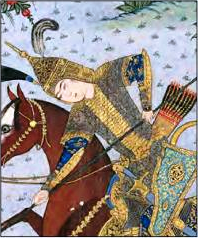Biography
In 590, Bahram mounted a large-scale rebellion against the Sasanian family, forcing the newly ascended ruler Khosrow II to flee, while taking the throne for himself. He was the following year defeated and killed. Not long after, Khosrow II's uncle Vistahm rebelled against him, carving a principality for himself in the entire eastern and northern quadrants of the Iranian realm. It was during this period that he married Gordiya, consequently increasing his status. His rebellion, however, also proved unsuccessful; according to some accounts, he was killed by Hephthalite subject Pariowk, whilst an alternative account states that it was Gordiya who killed him after being given the promise of marriage in return by Khosrow II. The 9th-century historian Dinawari mentioned a son of Gordiya and Khosrow, named Juvansher, as reigning as monarch of Iran briefly in 630. This king however remains obscure, and none of his coins have yet been found.
This page is based on this
Wikipedia article Text is available under the
CC BY-SA 4.0 license; additional terms may apply.
Images, videos and audio are available under their respective licenses.




